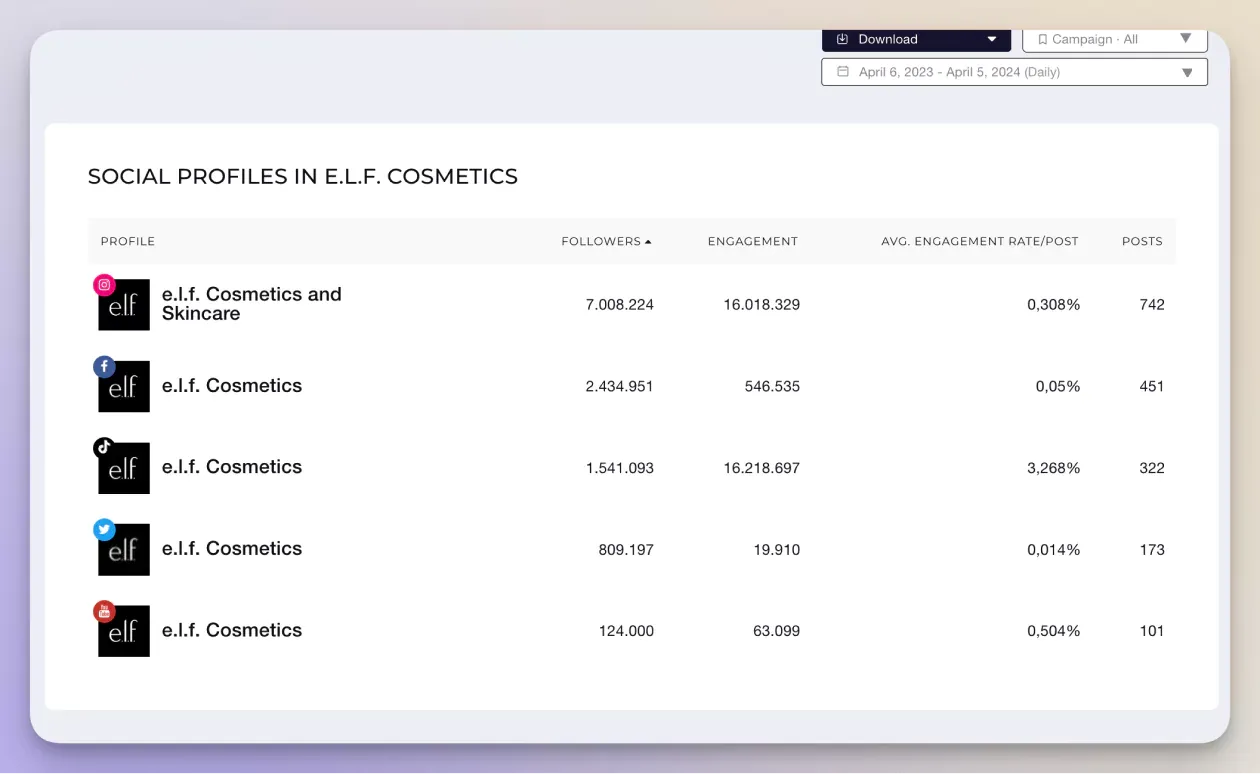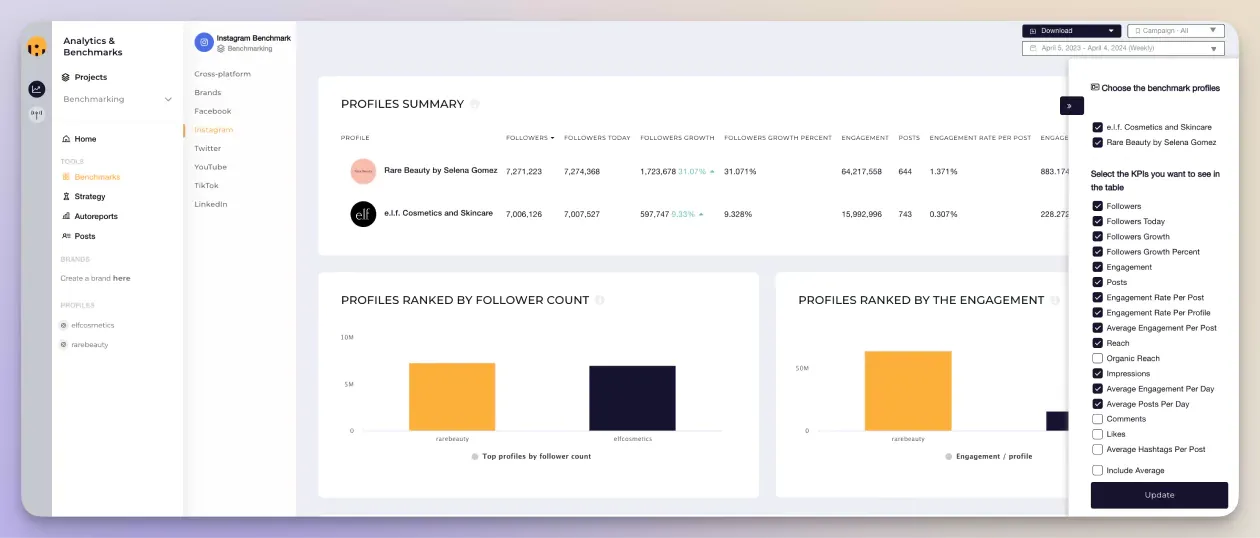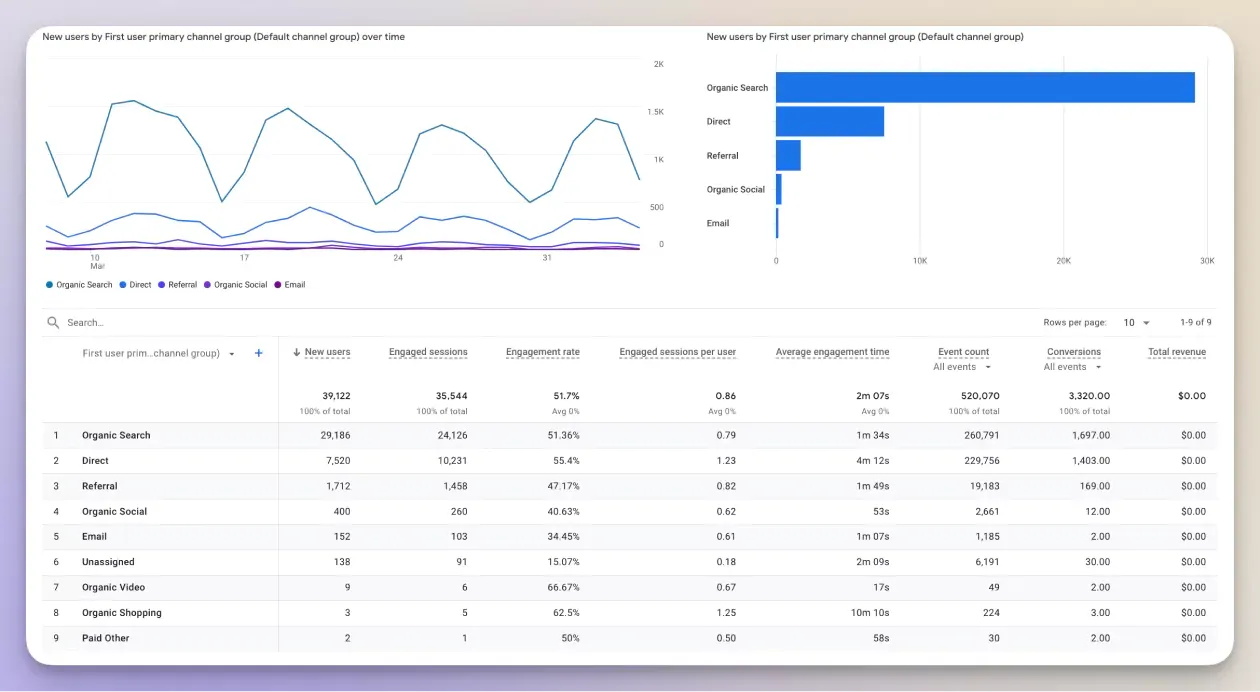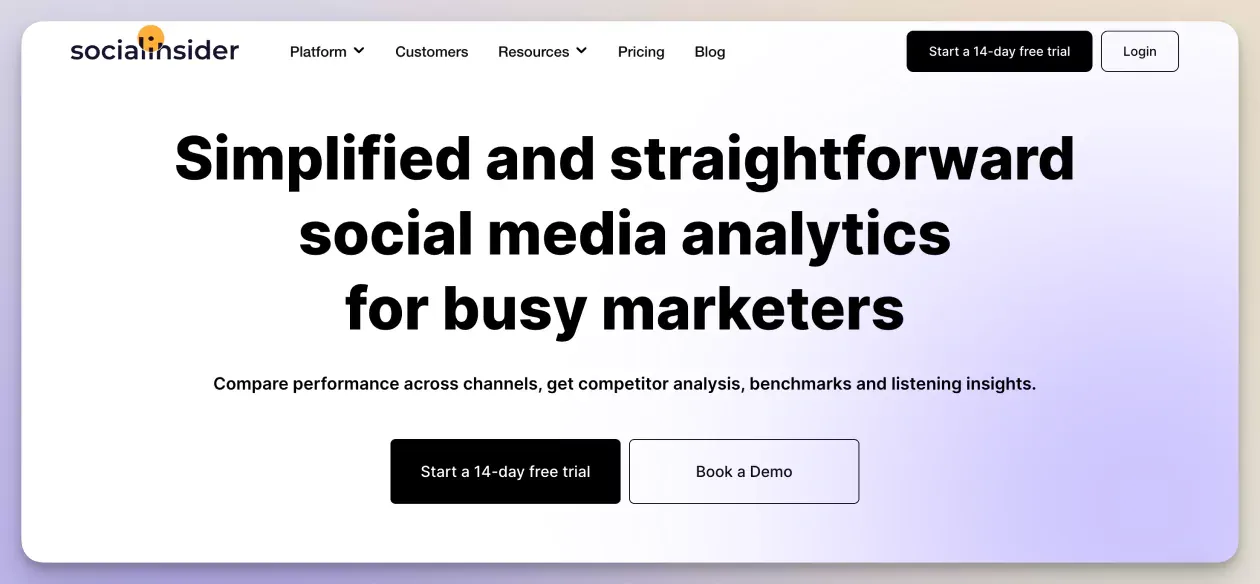The world of social media might seem like a Van-Gogh-swirl of data, photos, videos and memes with a black hole at its end, absorbing users’ energy and attention.
When you’re in charge of your brand’s social media accounts and learn to develop a social media report, the struggle is real. And the picture becomes even more blurry.
Luckily for you and all digital marketers out there who are desperately looking for help, today we're going to learn together how to develop social media analytics reports and how to use reports templates to make our job easier.
How to make a social media report
1. What is a social media report?
2. How to create a social media report
- Choose the KPIs that are relevant to you
- Gather the data
- Measure performance on a set time frame
- Get cross platform insights
- Provide competitive data
- Include actionable insights
3. What to include in a social media report
- Followers or fans growth
- Engagement and engagement rates
- Reach and impressions
- Branded hashtags' performance
- Post performance
- Sentiment analysis
- Traffic and leads
- CTR
- Posting frequency
4. Types of social media reports
5. Download free social media report templates
6. Best social media reporting tools
1. What is a social media report?
A social media report is a presentation that includes social media data and insights gathered with the purpose of evaluating a brand's performance on social media.
Through social media analytics reports, marketers can glance at their strategies' effectiveness in achieving their social media goals, becoming a key factor in a marketing plan optimization process.
2. How to create a social media report
To benefit the most from their analysis time, when creating a social media performance report, digital marketers are recommended to follow a logical and structured framework in order to discover valuable insights.
So, moving forward, we'll describe the steps you'll need to cover to create a top-notch social media analytics report.
-
Choose the KPIs that are relevant to you
The very purpose of a social media report is to offer an overview of how successful your brand's content strategy was in getting more attention toward the business.
Depending on your social media goals - be it primarily to increase brand awareness, engagement, or sales - different metrics will land in your social media report.
Defining the KPIs you'll integrate into your performance analysis is probably the most important step of social media reporting, given that you'll draw some optimization strategies based on that further in the process.
-
Gather the data
Bringing together the data from all your analytics sources will allow you to get a broader picture of your brand's social media performance, providing a deeper understanding of how different tactics and mediums have worked.
To create an in-depth social media report while equally saving time on your analysis, you can leverage a data solution tool, such as Socialinsider, that helps you access your social media KPIs in just a matter of seconds while also providing visually appealing performance statistics.
-
Measure performance on a set time frame
After choosing the metrics you'll focus on for your social media reporting and having put together all the data you need, it's time to start analyzing the numbers to see if your expectations have been met and if your strategies were effective in getting the results you were after.
For specific campaign evaluation, it's recommended that you run your analysis over its specific duration.
Moreover, if we're talking about a recurring campaign, making a comparison between current and past data may come in handy for you to evaluate if, in the future, it's worth leveraging it any longer.
-
Get cross-platform insights
To get an in-depth understanding of how your brand is performing on social media and which channels are the most effective and deserve more investment in terms of attention and budget, we recommend integrating multi-platform data into your social media reports.

By using Socialinsider's Brands feature you can run a comparative analysis between you channel's performance in terms of followers, engagement, impressions and much more.
Here are the steps I've followed for this process:
- I added the brand's profiles within Socialinsider by adding the corresponding URLs.
- Then I went to the Home section and created the brand e.l.f Cosmetics, while selecting which brand channels I want to include in my analysis.
- In the end, I clicked on the brand created, displayed in the left-sided section of the menu, and scrolled down through the data.
-
Dive into audience demographics
Understanding your audience is key to your social media strategy's success. So, when you're creating your social media performance report, diving into audience data alongside other KPIs can offer you precious insights into the effectiveness of your social media content in attracting your buyer personas.
Here's what I mean: if your follower base is formed of your target audience (as revealed by the data), then looking into what post types are the most appealing will offer you some optimization directions. However, if you discover the opposite case, then that's a clear indicator of your need to revisit your strategy on a bigger scale.
-
Provide competitive data
Keeping an eye on what your competitors are doing on social media is only natural. And this is some valuable data you can include in your social media report.
This way, you will know how much you grow in relation to your past self, but you will also register your progress compared to your competition.
By using Socialinsider, you just have to go to Benchmarks and you will see how you stand in your market against your competition. Here is how to do it.
I create a project in which I included the Instagram profiles for Rare Beauty and e.l.f Cosmetics. By clicking Benchmarks, I can see their performance for the selected time frame.

Here you can select what metrics and insights to compare between your brand and your competitor.
By scrolling down, you will see metrics likes fan count, engagement, top 3 posts for each of the two brands, average engagement, average posts per day, distribution of engagement, distribution of posts and many more.
While this is a social media analytics report sample, Socialinsider offers a wider range of metrics you can look at once signing up for a free trial!
-
Include actionable insights
Once you have collected all the relevant metrics for your analysis and made correlations between the numbers, you have one final step you need to check for a top-notch social media report. That is coming up with improvement ideas based on what the data told you.
By looking at what you achieved in the time frame you’ve selected to look at examining what tactics proved to work and which didn't, you are now prepared for better predictions in the future.
Put them into practice, and you'll be on your way to great social media success.
3. What to include in a social media report
When building your social media report, you need to make sure you map out the trajectory for your brand.
You need to look at the clarity metrics that will help you build a strong brand reputation.
Sometimes it can be tough to manage a lot of data, which can result in getting lost in a sea of information. That’s why it’s important to quantify the metrics that drive value for your brand or your clients.
Here is a list of the key metrics you should monitor:
-
Followers or fans growth
This social media metric helps you assess how many followers you gain or lose month over month.
In case you are losing followers, you know that you need to work on your content to make them stick with your brand and later become part of your community.
-
Engagement and engagement rates
Engagement is a game-changing metric that you should always guard, like a princess in a tower. A high engagement rate can be correlated with a higher reach and a broader community.
If your content drives users to interact with it, then you’re winning at social media.
There are two main ways of looking at engagement:
- The overall engagement shows how much people have liked, commented and, depending on the platform, shared the entirety of your content.
- The engagement rate per post shows how people interact, on average, with one of your posts
-
Reach and impressions
These two metrics are crucial in understanding how far your messages can go. Engagement might mean nothing if your posts don’t really reach a wide audience.
These two metrics tell you how many times a post has been viewed and how many unique views it has had.
Reach represents the total number of unique users who see your content.
Impressions shows the total number of times your content is displayed in users' feeds, even if t
-
Branded hashtags’ performance
With the help of a third-party analytics tool or, even better, a social listening tool, you can also look at how the hashtags used in your posts work.
They can push your content in front of users, making them viral while increasing brand awareness.
You can check how much engagement your brand’s hashtags bring. This insight will help you determine what hashtags you should continue to use and when.
A listening tool will help you see the volume of hashtags, while discovering sentiment analysis.
This will help you better understand what the audience thinks about your new campaign and whether they use the hashtag in a positive or negative post.
You should also check video views' insights and creators data, when it comes to TikTok and Instagram Reels.
-
Post performance
No matter how many social media platforms you build your presence on, if you haven’t tried all types of posts on that platform, your efforts are not yet repaid.
Consider posting images, text, polls, Reels, carousels, videos, stories and see what impact your content has on users.
Not only is it important to analyze how you divide your content between images, videos and carousels, but you must also look at what type of post results in higher engagement.
A lot of insights can be gained just by looking at your top-performing posts when doing your social media performance reporting, and understanding what are your social account’s strengths.
You’ll be able to see:
- what type of content you’ve used
- how long the captions were
- what were the main topics of interest
- what hashtags you’ve used
- engagement metrics
- impression metrics
- likes
- comments
Find out more metrics in this complete list you should follow
-
Sentiment analysis
Social media sentiment is a metric that follows a customer’s perception of a brand, service or product.
Based on that customer’s opinion about a specific product, you can build your entire marketing and social media strategy around it.
You can leverage customers’ comments and posts about your brand to develop better products and services.
It is really important to find out what users say about your brand “behind your back”, when they don’t tag you.
This will help you get some honest opinions that you can further use when designing your content.
-
Traffic and leads
One of your aims is to increase traffic on your website through all the posts you publish on social media.
You can check Google Analytics to track what links users have clicked and how did they get on your website.
You should especially check what articles or features users where interested in to focus more on those specific parts of your website.
Here is a screenshot from Google Analytics showing where traffic comes from.

When checking for leads, you have to pay attention to the actions users make after clicking a link from your social media posts.
However, there are a bunch of tools that can help you get in-depth data on a user's journey once they get to your website, what studies they download, what they read, and whether they subscribe to your newsletter or not.
-
Click-through-rate (CTR)
Whether you've been running an ad campaign or you just want to check how many people click on the links you include in your posts, CTR, or Click-Through Rate can help you measure that.
CTR helps marketers understand how engaging their content is and how well it resonates with their target audience.
-
Posting frequency
One other last metric you should include in your social media performance reports is posting frequency. It's especially relevant in correlation with other metrics such as engagement or impressions.
4. Types of social media reports
Depending on the purpose of the report (be it to evaluate a specific campaign or a quarter's strategy results), there are multiple types of social media reports.
While most digital marketers leverage quarterly social media reporting, some may need to check the data more often - to optimize on the go so that they could keep their competitive advantage - running monthly or even weekly social media reports.
Lastly, with yearly reports offering an overview of a brand's performance across an entire year, this type of social media report is also very important, highlighting what campaigns should be kept and improved over the next year and which shouldn't. It also offers great insights into how the budget should be allocated.
5. Download free social media report templates
When you're in a rush because the clock is ticking until you have to turn in your performance presentation, a social media report template can surely save the day.
Obviously, depending on your client's preferences or even your own company style, when looking for a social media analytics report template, you may be searching for a specific format, such as PDF, PowerPoint, or Excel.
In the end, it’s probably all a matter of what is more important to you: data flexibility or design.
So, to help you cut the search short, we've put together a couple of social media report templates at your disposal, which are listed below.
📌 Download your social media performance report template in an Excel format
📌 Download your social media analysis report template in a PowerPoint format
6. Best tools for reporting on social media
To develop the most accurate social media performance reports, you should take advantage of the wide pool of tools that could help.
Here is our list of the most powerful social media reporting tools you should try:
Native analytics
Every social platform's native analytics offers powerful data that can help marketers shape better strategies.
In TikTok's case, for example, by leveraging the platform's analytics, you can get in-depth data, such as profile views, demographic insights, and more detailed KPIs that will unlock more effective campaigns.
Socialinsider

Socialinsider is an easy-to-use social media analytics and benchmarking tool that enables quick yet thorough social media reporting.
Besides the metrics offered by any social platform's native analytics, this tool also provides a series of extensive KPIs, helping marketers get more in-depth data and gain a deeper understanding of their brand's social media performance.
Also, one of Socialinsider's most helpful features for creating top-notch social media reports is its benchmarking analytics solution, which empowers brands with competitive insights.
By analyzing competitors' KPIs, marketers can identify best-performing strategies and campaigns. Moreover, they can gain content and partnership inspiration, which can enable a competitive advantage.
Last but not least, Socialinsider also supports an Instagram listening module through which brands can take a look at brand-related conversations, get sentiment and emotion insights, and manage brand reputation.
Google Analytics
For brands that have centered their social media strategy around the goal of increasing sales, Google Analytics is a must-have tool for their social media reporting.
Enabling social media traffic tracking, this tool helps marketers understand if their social media content is effective in making consumers visit the brand's website, which increases the purchase possibility.
Final thoughts
Covering everything from formats to metrics that matter, we hope this guide on how to create a social media report was useful for you.
When creating your own social media performance reports, remember to adapt the information you've found to what your brand's needs are.
FAQs about social media reporting
1. What are the five steps to create a social media report?
Here are five steps to create any comprehensive social media report:
- set goals and define your KPIs
- collect data from social media anaytics and reporting tools
- analyze and interpret the results
- compile your report, including charts and graphs to present data visually
- outline some actionable insights for the future
2. What should be included in a social media report?
What you include in your social media report depends entirely on your company's or client's goals for social media marketing.
However, most social media reports cover KPIs such as engagement, reach & impressions, audience growth, CTR and so on, as well as charts for easy data visualization, and a few actionable insights at the end.






